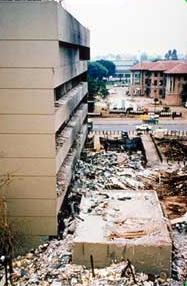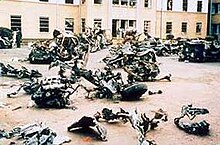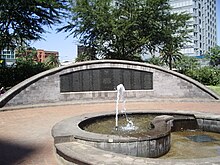1998 United States embassy bombings
From Wikipedia, the free encyclopedia
| 1998 United States embassy bombings | |
|---|---|

Aftermath at the U.S. embassy in Nairobi
| |
| Location | Dar es Salaam, Tanzania Nairobi, Kenya |
| Coordinates | 1°17′S 36°49′E and 6°48′S 39°17′E |
| Date | 7 August 1998 10:30 a.m. – 10:40 a.m. (UTC+3) |
| Target | United States embassies |
Attack type
| Truck bombs |
| Weapons | TNT, ammonium nitrate, pistol,stun grenade |
| Deaths | 224 |
Non-fatal injuries
| More than 4,000 |
| Assailants | al-Qaeda and Egyptian Islamic Jihad |
| ||
The 1998 United States embassy bombings were attacks that occurred on 7 August 1998, in which over 200 people were killed in nearly simultaneous truck bomb explosions in two East African cities, one at the United States Embassy in Dar es Salaam, Tanzania, the other at the United States Embassy in Nairobi, Kenya.[1]
The attacks, which were linked to local members of the Egyptian Islamic Jihad, brought Osama bin Laden and Ayman al-Zawahiri—and their terrorist organization al-Qaeda—to the attention of the American public for the first time, and resulted in the Federal Bureau of Investigation (FBI) placing bin Laden on its ten most-wanted fugitives list. The FBI also connected the attack to Azerbaijan, as 60 calls were placed via satellite phone by bin Laden to associates in the country's capital Baku.[2] Fazul Abdullah Mohammed and Abdullah Ahmed Abdullah were credited for being the masterminds behind the bombings.[3][4][5]
Contents
[hide]Motivation and preparation[edit]
The bombings are widely believed to have been revenge for American involvement in the extradition, and alleged torture, of four members of Egyptian Islamic Jihad (EIJ) who had been arrested in Albania for an alleged series of murders in Egypt in the two months prior to the attacks.[6] Between June and July, Ahmad Isma'il 'Uthman Saleh, Ahmad Ibrahim al-Sayyid al-Naggar, Shawqi Salama Mustafa Atiya and Mohamed Hassan Tita were all renditioned from Albania to Egypt, with the co-operation of the United States; the four men were accused of participating in the assassination of Rifaat el-Mahgoub, as well as a later plot against the Khan el-Khalili market in Cairo.[7] The following month, a communique was issued warning the United States that a "response" was being prepared to "repay" them for their interference.[8][9] However, the 9/11 Commission Report claims that preparations began shortly after bin Laden issued his February 1998 fatwa.[10]
According to journalist Lawrence Wright, the Nairobi operation was named after the Holy Kaaba in Mecca; the Dar es Salaam bombing was called Operation al-Aqsa in Jerusalem, but "neither had an obvious connection to the American embassies in Africa. Bin Laden initially said that the sites had been targeted because of the 'invasion' of Somalia; then he described an American plan to partition Sudan, which he said was hatched in the embassy in Nairobi. He also told his followers that the genocide in Rwanda had been planned inside the two American embassies." Wright concludes that bin Laden's actual goal was "to lure the United States intoAfghanistan, which had long been called 'The Graveyard of Empires.'"[11]
In May 1998, a villa in Nairobi was purchased by one of the bombers to enable a bomb to be built in the garage. Sheikh Ahmed Salim Swedan purchased a beige Toyota Dyna truck in Nairobi and a 1987 Nissan Atlasrefrigeration truck in Dar es Salaam. Six metal bars were used to form a "cage" on the back of the Atlas to accommodate the bomb.[12]
In June 1998, KK Mohamed rented House 213 in the Illala district of Dar es Salaam, about four miles (6 km) from the US Embassy. A white Suzuki Samurai was used to haul bomb components hidden in rice sacks, from House 213.[citation needed]
In both Nairobi and Dar es Salaam, Mohammed Odeh supervised construction of two very large, 900 kg destructive devices. The Nairobi bomb was made of 400 to 500 cylinders of TNT (about the size of drinks cans), ammonium nitrate, aluminium powder and detonating cord. The explosives were packed into twenty specially designed wooden crates that were sealed and then placed in the bed of the trucks. Muhsin Musa Matwalli Atwah ran a wire from the bomb to a set of batteries in the back of the truck cab and then to a detonator switch beneath the dashboard.[12] The Dar es Salaam bomb was of slightly different construction: the TNT was attached to fifteen oxygen tanks and gas canisters, and was surrounded with four bags of ammonium nitrate fertiliser and some sand bags to tamp and direct the blast.[13]
The bombings were scheduled for 7 August, the eighth anniversary of the arrival of American troops in Saudi Arabia during the early stages of the Persian Gulf War, likely a choice by Osama bin Laden.[14]
Attacks and casualties[edit]
On 7 August, between 10:30 a.m. and 10:40 a.m. local time (3:30–3:40 a.m. EST), suicide bombers in trucks laden with explosives parked outside the embassies in Dar es Salaam and Nairobi, and almost simultaneously detonated.[15] 213 people were killed in the Nairobi blast, while 11 were killed in Dar es Salaam.[16] An estimated 4,000 in Nairobi were wounded, and another 85 in Dar es Salaam.[citation needed] Seismological readings analysed after the bombs indicated energy of between 3–17 tons of high explosive material.[17] Although the attacks were directed at American facilities, the vast majority of casualties were local citizens of the two African countries; 12 Americans were killed,[18] including two Central Intelligence Agency employees in the Nairobi embassy, Tom Shah and Molly Huckaby Hardy,[19] and one U.S. Marine, Sergeant Jesse Aliganga, a Marine Security Guard at the Nairobi embassy.[20][21] U.S. Army Sergeant Kenneth R. Hobson II was one of the 12 Americans killed in the attack.[citation needed]
While driver Azzam drove the Toyota Dyna quickly toward the Nairobi embassy along with Mohamed Rashed Daoud Al-Owhali,[22] local security guard Benson Okuku Bwaku was warned to open the gate immediately – and fired upon when he refused to comply. Al-Owhali threw a stun grenade at embassy guards before exiting the vehicle and running off.[23] Osama bin Laden later offered the explanation that it had been Al-Owhali's intention to leap out and shoot the guards to clear a path for the truck, but that he had left his pistol in the truck and subsequently ran off.[22] As Bwaku radioed to Marine Post One for backup, the truck detonated.[23]
The explosion damaged the embassy building and collapsed the neighbouring Ufundi Building where most victims were killed, mainly students and staff of a secretarial college housed here. The heat from the blast was channelled between the buildings towards Haile Selassie Avenue where a packed commuter bus was burned. Windows were shattered in a radius of nearly 1 kilometre. A large number of eye injuries occurred because people in buildings nearby who had heard the first explosion of the hand grenade and the shooting went to their office windows to have a look when the main blast occurred and shattered the windows.[citation needed]
Meanwhile, the Atlas truck in Dar es Salaam was being driven by Hamden Khalif Allah Awad, known as "Ahmed the German" due to his blonde hair, a former camp trainer who had arrived in the country only a few days earlier.[12]The death toll was less than in Nairobi as the US embassy was located outside the city center on Bagamoyo Road on a large plot with no immediate neighbours close to the gate where the explosion occurred.[citation needed]
Following the attacks, a group calling itself the "Liberation Army for Holy Sites" took credit for the bombings. American investigators believe the term was a cover used by Egyptian Islamic Jihad, who had actually perpetrated the bombing.[24]
Aftermath and international response[edit]
In response to the bombings, President Bill Clinton ordered Operation Infinite Reach, a series of cruise missile strikes on targets in Sudan and Afghanistan on 20 August 1998, announcing the planned strike in a prime time address on American television.[citation needed]
The United Nations Security Council passed Resolution 1189 condemning the attacks on the embassies.[25]
Both embassies were heavily damaged and the Nairobi embassy had to be rebuilt. It is now located across the road from the United Nations Office at Nairobi for security purposes.
Within months following the bombings, the United States Department of State Bureau of Diplomatic Security added Kenya to its Antiterrorism Assistance Program (ATA), which was originally created in 1983. While the addition was largely a formality to reaffirm America's commitment to fighting terrorism in Kenya, it nonetheless sparked the beginning of an active bilateral antiterrorism campaign between the United States and Kenya. The US Government also rapidly and permanently increased the monetary aid to Kenya. Immediate changes included a $42 million grant targeted specifically towards Kenyan victims.[26]
Indictment[edit]
Following the investigation, an indictment was issued. It charges the following 21 people for various alleged roles in the bombings.[27] 18 of the cases have been settled.
| Name | Disposition |
|---|---|
| Osama bin Laden | Killed in Abottabad, Pakistan on 2 May 2011 |
| Muhammad Atef | Killed in Kabul, Afghanistan on 14 November 2001 |
| Ayman al Zawahiri | Fugitive |
| Saif al Adel | Fugitive |
| Mamdouh Mahmud Salim | Serving sentence of life imprisonment in the United States[28] |
| Abdullah Ahmed Abdullah | Fugitive |
| Muhsin Musa Matwalli Atwah | Killed in Naghar Kalai, Pakistan on 12 April 2006 |
| Khalid al Fawwaz | Serving sentence of life imprisonment in the United States[29] |
| Wadih el Hage | Serving sentence of life imprisonment in the United States[30] |
| Anas al Libi | Died in 2015 while awaiting trial in the United States |
| Ibrahim Eidarous | Died in 2008 while under house arrest in the United Kingdom |
| Adel Abdel Bari | Serving sentence of 25 years imprisonment in the United States[31] |
| Fazul Abdullah Mohammed | Killed in Mogadishu, Somalia by Somali government troops on 8 June 2011 |
| Ahmed Mohammed Hamed Ali | Killed in Pakistan in 2010[32] |
| Mohammed Sadeek Odeh | Serving sentence of life imprisonment in the United States[33] |
| Mohamed Rashed Daoud al-'Owhali | Serving sentence of life imprisonment in the United States[34] |
| Mustafa Mohamed Fadhil | Killed in Afghanistan.[35][36][37] |
| Khalfan Khamis Mohamed | Serving sentence of life imprisonment in the United States[38] |
| Ahmed Khalfan Ghailani | Serving sentence of life imprisonment in the United States[39] |
| Fahid Mohammed Ally Msalam | Killed in Pakistan on 1 January 2009 |
| Sheikh Ahmed Salim Swedan | Killed in Pakistan on 1 January 2009 |
See also[edit]
References[edit]
- ^ http://hir.harvard.edu/religion/lifting-the-veil?page=0,1
- ^ "Book Review: ‘Mercenaries, Extremists, and Islamist Fighters in Karabagh War". Armenian Weekly. Retrieved21 January 2013.
- ^ Bennett, Brian (12 June 2011). "Al Qaeda operative key to 1998 U.S. embassy bombings killed in Somalia". Los Angeles Times.
- ^ "Al-Qaida timeline: Plots and attacks – World news – Hunt for Al-Qaida | NBC News". MSNBC. Retrieved 21 January 2013.
- ^ "Читать онлайн "The Black Banners" автора Soufan Ali H. - RuLit - Страница 83".
- ^ Mayer, Jane (2008). The Dark Side: The Inside Story of How The War on Terror Turned into a War on American Ideals. New York: Doubleday. p. 114. ISBN 978-0-385-52639-5.
- ^ Advocate, Victoria (13 August 1998). "Bombings connect to mysterious arrests".
- ^ "Summary of the Security Intelligence Report concerning Mahmoud Jaballah" (Pdf). Canadian Security Intelligence Service. 22 February 2008.
- ^ Higgins, Andrew (20 November 2001). "A CIA-Backed Team Used Brutal Means to Crack Terror Cell". Wall Street Journal.
- ^ 9/11 Commission Report p. 69
- ^ Wright, Lawrence (2006). Looming Tower: Al Qaeda and the Road to 9/11. New York: Knopf. p. 272. ISBN 0-375-41486-X.
- ^ a b c Benjamin, Daniel; Simon, Steven (2002). The Age of Sacred Terror. New York: Random House. ISBN 0-375-50859-7.
- ^ Hamm, Mark S. (2007). Terrorism as Crime: From Oklahoma City to Al-Qaeda and Beyond. NYU Press. ISBN 978-0-8147-3696-8. Retrieved 13 September 2011.[page needed]
- ^ Gunaratna, Rohan (2002). Inside Al Qaeda. New York: Columbia University Press. p. 46. ISBN 0-231-12692-1.
- ^ "U.S. Embassy Bombings". U.S. Department of State website. Archived from the original on 5 August 2007. Retrieved 4 August 2007.
- ^ "Frontline: The trail of evidence - FBI executive summary". PBS.org. Retrieved 2 May 2014.
- ^ "Some Practical Applications of Forensic Seismology"(PDF). Retrieved





No comments:
Post a Comment